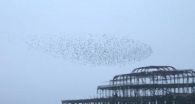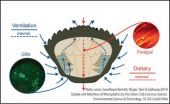(Press-News.org) New research provides an intriguing glimpse into the processes that establish connections between nerve cells in the brain. These connections, or synapses, allow nerve cells to transmit and process information involved in thinking and moving the body.
Reporting online in Neuron, researchers at Washington University School of Medicine in St. Louis have identified a group of proteins that program a common type of brain nerve cell to connect with another type of nerve cell in the brain.
The finding is an important step forward in efforts to learn how the developing brain is built, an area of research essential to understanding the causes of intellectual disability and autism.
"We now are looking at how loss of this wiring affects brain function in mice," said senior author Azad Bonni, MD, PhD, the Edison Professor of Neurobiology and head of the Department of Anatomy and Neurobiology at the School of Medicine.
Bonni and his colleagues are studying synapses in the cerebellum, a region of the brain that sits in the back of the head. The cerebellum plays a central role in controlling the coordination of movement and is essential for what researchers call procedural motor learning, which makes it possible to move our muscles at an unconscious level, such as when we ride a bicycle or play the piano.
"The cerebellum also regulates mental functions," Bonni said. "So, impairment of the wiring of nerve cells in the cerebellum may contribute to movement disorders as well as cognitive problems including autism spectrum disorders."
His new results show that a complex of proteins known as NuRD (nucleosome remodeling and deacetylase) plays a fairly high supervisory role in some aspects of the cerebellum's construction. When the researchers blocked the NuRD complex, cells in the cerebellum called granule cells failed to form connections with other nerve cells, the Purkinje neurons. These circuits are important for the cerebellum's control of movement coordination and learning.
Bonni and his colleagues showed that NuRD exerts influence at the epigenetic level, which means it controls factors other than DNA that affect gene activity. For example, NuRD affects the configurations of molecules that store DNA and that can open and close the coils of DNA like an accordion, making genes less or more accessible. Changing the accessibility of genes changes their activity levels. For instance, cells can't frequently make proteins from genes in a tightly packed coil of DNA.
NuRD also alters tags on the proteins that store DNA, decreasing the chances that the gene will be used. Among the genes deactivated by NuRD are two that control the activity of other genes involved in the wiring of the cerebellum.
"This tells us that the NuRD complex is very influential—not only does it affect the activity of genes directly, it also controls other regulators of multiple genes," Bonni said.
INFORMATION:
Funding from the National Institutes of Health (NIH) (NS041021, NS032405, NS007484), the Mathers Foundation and the Japan Society for the Promotion of Science supported this research.
Yamada T, Yang Y, Hemberg M, Yoshida T, Cho HY, Murphy JP, Fioravante D, Regehr WG, Gygi SP, Georgopoulos K, Bonni A. Promoter decomissioning by the NuRD chromatin remodeling complex triggers synaptic connectivity in the mammalian brain. Neuron, July 2, 2014.
Washington University School of Medicine's 2,100 employed and volunteer faculty physicians also are the medical staff of Barnes-Jewish and St. Louis Children's hospitals. The School of Medicine is one of the leading medical research, teaching and patient-care institutions in the nation, currently ranked sixth in the nation by U.S. News & World Report. Through its affiliations with Barnes-Jewish and St. Louis Children's hospitals, the School of Medicine is linked to BJC HealthCare.
Scientists find new clues to brain's wiring
2014-07-18
ELSE PRESS RELEASES FROM THIS DATE:
Measuring the number of protein molecules inside cells
2014-07-18
This news release is available in Portuguese. This news release is available in Portuguese.
The identification of the genes and proteins involved in a biological process, as well as the way they interact, are essential for the understanding of that process. However, often little is known about the dimensions of molecular biological structures. Knowing how many molecules make up a structure and are required for its function are essential for our understanding of biological mechanisms. Yet, quantifying molecules of infinitesimal size poses a difficult challenge. ...
Revealed: The mystery behind starling flocks
2014-07-18
The mystery behind the movements of flocking starlings could be explained by the areas of light and dark created as they fly, new research suggests.
The research, conducted by the University of Warwick and published in the journal PNAS, found that flocking starlings aim to maintain an optimum density at which they can gather data on their surroundings. This occurs when they can see light through the flock at many angles, a state known as marginal opacity. The subsequent pattern of light and dark, formed as the birds attempt to achieve the necessary density, is what provides ...
Adults with eosinophilic esophagitis should consider a diet change
2014-07-18
Bethesda, MD (July 18, 2014) — Dietary elimination is a successful method of treatment for adults with eosinophilic esophagitis (EoE), according to a new study1 in Clinical Gastroenterology and Hepatology, the official clinical practice journal of the American Gastroenterological Association.
"By eliminating specific foods from patients' diets, symptoms improved in 71 percent of patients, and endoscopic appearance improved in 54 percent," said lead study author, W. Asher Wolf, MD, MPH, and co-author Evan S. Dellon, MD, MPH, from the division of gastroenterology and hepatology, ...
Genetic variations may modify cardiovascular benefit of aspirin
2014-07-18
BOSTON – Aspirin is the gold standard for antiplatelet therapy and a daily low-dose aspirin is widely prescribed for the prevention of cardiovascular disease.
Now, a new study suggests that common genetic variation in the gene for catechol-O-methyltransferase (COMT) may modify the cardiovascular benefit of aspirin, and in some people, may confer slight harm. The findings, led by investigators at Beth Israel Deaconess Medical Center (BIDMC) and Brigham and Women's Hospital (BWH) appear online in the American Heart Association journal Arteriosclerosis, Thrombosis, and ...
Microplastics worse for crabs and other marine life than previously thought, study shows
2014-07-18
The tiny plastic particles polluting our seas are not only orally ingested by marine creatures, but also enter their systems through their gills, according to a new study led by the University of Exeter.
Scientists also discovered that when microplastics are drawn in through this method they take over six times longer to leave the body compared with standard digestion.
Lead author Dr Andrew Watts of the University of Exeter said: "Many studies on microplastics only consider ingestion as a route of uptake into animals. The results we have just published stress other ...
The bend in the Appalachian mountain chain is finally explained
2014-07-18
The 1500 mile Appalachian mountain chain runs along a nearly straight line from Alabama to Newfoundland—except for a curious bend in Pennsylvania and New York State. Researchers from the College of New Jersey and the University of Rochester now know what caused that bend—a dense, underground block of rigid, volcanic rock forced the chain to shift eastward as it was forming millions of years ago.
According to Cindy Ebinger, a professor of earth and environmental sciences at the University of Rochester, scientists had previously known about the volcanic rock structure under ...
Immune cell's role in intestinal movement may lead to better understanding of IBS
2014-07-18
Learning the role of immune-system cells in healthy digestive tracts and how they interact with neighboring nerve cells may lead to new treatments for irritable bowel syndrome (IBS). Researchers from Penn State College of Medicine, in collaboration with other scientists, have reported the role of macrophages in regulating the contractions of the colon to push digested material through the digestive tract.
The muscular lining of the intestine contains a distinct kind of macrophage, an immune system cell that helps fight infections. The role of these cells in normal colon ...
It's go time for LUX-Zeplin dark matter experiment
2014-07-18
New Haven, Conn. -- From the physics labs at Yale University to the bottom of a played-out gold mine in South Dakota, a new generation of dark matter experiments is ready to commence.
The U.S. Department of Energy's Office of Science and the National Science Foundation recently gave the go-ahead to LUX-Zeplin (LZ), a key experiment in the hunt for dark matter, the invisible substance that may make up much of the universe. Daniel McKinsey, a professor of physics, leads a contingent of Yale scientists working on the project.
"We emerged from a very intense competition," ...
Improving driver safety: How to prevent streetlight glare in the new world of LED lighting
2014-07-18
WASHINGTON, July 18—Long hours of nighttime driving can cause eyestrain because while our vision adapts to the surrounding darkness, the sudden stabs of brightness from streetlamps can be irritating, distracting and even painful. Even as LED technology has transformed the lighting industry, bringing the promise of more energy-efficient road illumination, some fear that the new lights could cause even more troublesome, unsafe glare.
A team of researchers from China and the Netherlands has developed a way to evaluate the human impact of uncomfortable glare caused by LED ...
NASA sees super typhoon Rammasun eyeing landfall
2014-07-18
Imagery from NASA's Aqua satellite captured a wide-eyed Typhoon Rammasun as it was making landfall in northern Hainan Island, China early on July 18. A rainfall analysis using another NASA satellite showed the flooding potential of the storm as it left the Philippines and headed for China. Now, Rammasun is headed for a final landfall near the northeastern border of Vietnam and China.
On July 17, an analysis of Typhoon Rammasun's rainfall was conducted at NASA's Goddard Space Flight Center in Greenbelt, Maryland. The rainfall analysis covered the storm's rainfall from ...





